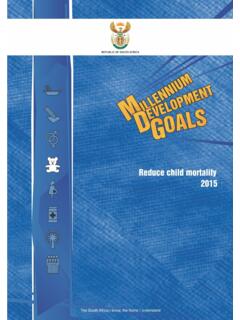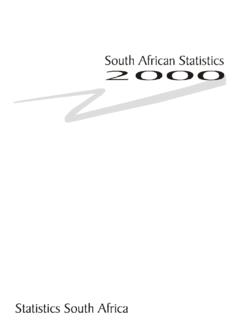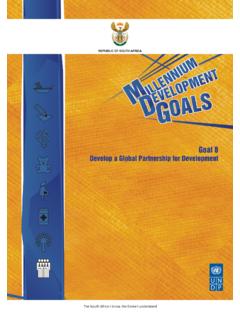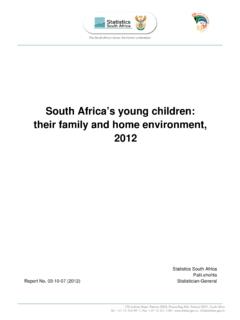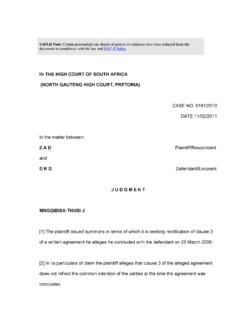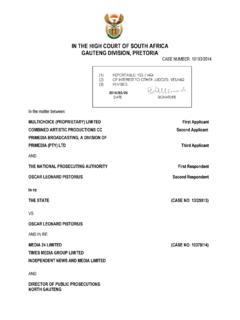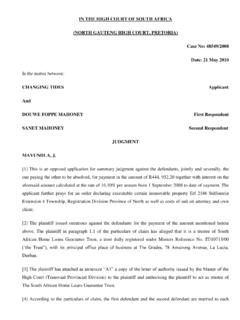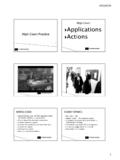Transcription of The South African MPI
1 The South africa I know, the home I understandThe South African MPIC reating a multidimensional poverty index using census data Statistics South africa Private Bag X44 pretoria 0001 South africa 170 Thabo Sehume Street pretoria 0002 User information service: 012 310 8600 Fax: 012 310 8500 Main switchboard: 012 310 8911 Fax: 012 321 7381 Website: Email: The South African MPI Creating a multidimensional poverty index using census data Statistics South africa , 2014 Pali Lehohla, Statistician-General Report No. 03-10-08 ii The South African MPI: Creating a multidimensional poverty index using census data / Statistics South africa Published by Statistics South africa , Private Bag X44, pretoria 0001 Statistics South africa , 2014 Users may apply or process this data, provided Statistics South africa (Stats SA) is acknowledged as the original source of the data; that it is specified that the application and/or analysis is the result of the user's independent processing of the data; and that neither the basic data nor any reprocessed version or application thereof may be sold or offered for sale in any form whatsoever without prior permission from Stats SA.
2 Stats SA Library Cataloguing-in-Publication (CIP) Data The South African MPI: Creating a multidimensional poverty index using Census data / Statistics South africa . pretoria : Statistics South africa , 2014 Report no.: 03-10-08 58pp ISBN 978-0-621-42616-8 A complete set of Stats SA publications is available at Stats SA Library and the following libraries: National Library of South africa , pretoria Division National Library of South africa , Cape Town Division Library of Parliament, Cape Town Bloemfontein Public Library Natal Society Library, Pietermaritzburg Johannesburg Public Library Eastern Cape Library Services, King William s Town Central Regional Library, Polokwane Central Reference Library, Nelspruit Central Reference Collection, Kimberley Central Reference Library, Mmabatho This report is available on the Stats SA website: For technical enquiries please contact: Ross Jennings Tel: (012) 337 6342 Email: Copies are obtainable from: Printing and Distribution, Statistics South africa Tel: (012) 310 8093 (012) 310 8619 Email.
3 Iii Contents List of tables .. iv List of figures .. v Preface .. 1 Introduction .. 2 What is multidimensional poverty? .. 2 The history of multidimensional poverty measurement by Stats SA .. 2 What is the MPI? .. 3 Constructing the South African MPI .. 4 Data sources .. 4 Exploring the data .. 5 The dimensions, the indicators and their deprivation cut-offs .. 5 The poverty cut-off .. 7 Limitations .. 8 Using the SAMPI .. 8 Profiling multidimensional poverty in South africa .. 9 The poverty measures .. 9 What is driving the poverty situation? .. 10 Poverty measures at a provincial level .. 11 Poverty profile: Western Cape .. 16 Poverty profile: Eastern Cape .. 20 Poverty profile: Northern Cape .. 24 Poverty profile: Free State .. 28 Poverty profile: KwaZulu-Natal .. 32 Poverty profile: North West .. 36 Poverty profile: Gauteng .. 40 Poverty profile: Mpumalanga .. 44 Poverty profile: Limpopo .. 48 Conclusion .. 52 The way forward .. 52 iv List of tables Table 1: The dimensions, indicators and deprivation cut-offs for SAMPI.
4 6 Table 2: Deprivation headcounts on each of the indicators .. 7 Table 3: The dimensions, indicators and their weights .. 8 Table 4: Poverty measures for Census 2001 and Census 2011 .. 9 Table 5: Intensity of deprivation amongst the poor .. 9 Table 6: Poverty measures for Census 2001 and Census 2011 at provincial level .. 11 Table 7: Poverty measures for Census 2001 and Census 2011 in Western Cape .. 16 Table 8: Poverty measures for Census 2001 and Census 2011 at municipal level in Western Cape .. 17 Table 9: Poverty measures for Census 2001 and Census 2011 in Eastern Cape .. 20 Table 10: Poverty measures for Census 2001 and Census 2011 at municipal level in Eastern Cape .. 21 Table 11: Poverty measures for Census 2001 and Census 2011 in Northern Cape .. 24 Table 12: Poverty measures for Census 2001 and Census 2011 at municipal level in Northern Cape .. 25 Table 13: Poverty measures for Census 2001 and Census 2011 in Free State .. 28 Table 14: Poverty measures for Census 2001 and Census 2011 at municipal level in Free State.
5 29 Table 15: Poverty measures for Census 2001 and Census 2011 in KwaZulu-Natal .. 32 Table 16: Poverty measures for Census 2001 and Census 2011 at municipal level in KwaZulu-Natal .. 33 Table 17: Poverty measures for Census 2001 and Census 2011 in North West .. 36 Table 18: Poverty measures for Census 2001 and Census 2011 at municipal level in North West .. 37 Table 19: Poverty measures for Census 2001 and Census 2011 in Gauteng .. 40 Table 20: Poverty measures for Census 2001 and Census 2011 at municipal level in Gauteng .. 41 Table 21: Poverty measures for Census 2001 and Census 2011 in Mpumalanga .. 44 Table 22: Poverty measures for Census 2001 and Census 2011 at municipal level in Mpumalanga .. 45 Table 23: Poverty measures for Census 2001 and Census 2011 in Limpopo .. 48 Table 24: Poverty measures for Census 2001 and Census 2011 at municipal level in Limpopo .. 49 v List of figures Figure 1: Dimensions and indicators of the MPI .. 3 Figure 2: Contribution of weighted indicators to SAMPI 2001 at national level.
6 10 Figure 3: Contribution of weighted indicators to SAMPI 2011 at national level .. 10 Figure 4: Poverty headcount (H) at provincial level in 2001 .. 12 Figure 5: Poverty headcount (H) at provincial level in 2011 .. 13 Figure 6: Poverty headcount (H) at municipal level in 14 Figure 7: Poverty headcount (H) at municipal level in 15 Figure 8: Contribution of weighted indicators to SAMPI 2011 in Western Cape .. 16 Figure 9: Poverty headcount (H) in Western Cape at municipal level in 2001 .. 18 Figure 10: Poverty headcount (H) in Western Cape at municipal level in 2011 .. 19 Figure 11: Contribution of weighted indicators to SAMPI 2011 in Eastern Cape .. 20 Figure 12: Poverty headcount (H) in Eastern Cape at municipal level in 2001 .. 22 Figure 13: Poverty headcount (H) in Eastern Cape at municipal level in 2011 .. 23 Figure 14: Contribution of weighted indicators to SAMPI 2011 in Northern Cape .. 24 Figure 15: Poverty headcount (H) in Northern Cape at municipal level in 2001 .. 26 Figure 16: Poverty headcount (H) in Northern Cape at municipal level in 2011.
7 27 Figure 17: Contribution of weighted indicators to SAMPI 2011 in Free State .. 28 Figure 18: Poverty headcount (H) in Free State at municipal level in 2001 .. 30 Figure 19: Poverty headcount (H) in Free State at municipal level in 2011 .. 31 Figure 20: Contribution of weighted indicators to SAMPI 2011 in KwaZulu-Natal .. 32 Figure 21: Poverty headcount (H) in KwaZulu-Natal at municipal level in 2001 .. 34 Figure 22: Poverty headcount (H) in KwaZulu-Natal at municipal level in 2011 .. 35 Figure 23: Contribution of weighted indicators to SAMPI 2011 in North West .. 36 Figure 24: Poverty headcount (H) in North West at municipal level in 2001 .. 38 Figure 25: Poverty headcount (H) in North West at municipal level in 2011 .. 39 Figure 26: Contribution of weighted indicators to SAMPI 2011 in Gauteng .. 40 Figure 27: Poverty headcount (H) in Gauteng at municipal level in 2001 .. 42 Figure 28: Poverty headcount (H) in Gauteng at municipal level in 2011 .. 43 Figure 29: Contribution of weighted indicators to SAMPI 2011 in Mpumalanga.
8 44 Figure 30: Poverty headcount (H) in Mpumalanga at municipal level in 2001 .. 46 Figure 31: Poverty headcount (H) in Mpumalanga at municipal level in 2011 .. 47 Figure 32: Contribution of weighted indicators to SAMPI 2011 in Limpopo .. 48 Figure 33: Poverty headcount (H) in Limpopo at municipal level in 2001 .. 50 Figure 34: Poverty headcount (H) in Limpopo at municipal level in 2011 .. 51 please scroll down 1 Preface The main purpose of this report is the provision of poverty maps and poverty data at provincial and municipal levels. In so doing, this report details how the South African Multidimensional Poverty Index (SAMPI) was conceptualised and constructed using data collected by Statistics South africa (Stats SA) through the censuses of 2001 and 2011. The SAMPI, based on the Alkire-Foster method, provides another powerful tool in Stats SA's ongoing efforts to measure poverty and deprivation in the country.
9 The strength of this index using census data rests in the ability to reliably map poverty down to whatever geographical level required and thus, will greatly assist municipalities in understanding the unique challenges facing their areas and how the situation on the ground has changed since 2001. The SAMPI was born out of the desire to develop a new product that could build onto the work started with the development of the Provincial Indices of Multiple Deprivation (PIMD) after Census 2001. Unlike the PIMD, the SAMPI has the advantage of being fully decomposable by demographic and geographic variables; this shows not only in what aspects the poor are deprived, but also reveals the interconnections among those deprivations. This will enable policymakers to better allocate resources and more effectively target policies. This report has benefitted from our on-going partnership with UNICEF. In addition to technical support on the analysis of child poverty, UNICEF has also generously supported efforts to build capacity for Stats SA staff to construct this SAMPI.
10 2 Introduction What is multidimensional poverty? Poverty is often defined by unidimensional measures, such as income or expenditure. While this provides us with a very useful way of measuring absolute poverty, it does not capture the multiple aspects that constitute poverty. Multidimensional poverty is made up of several factors that amount to a poor person s experience of deprivation these can include poor health, lack of education, inadequate living standards, lack of income, disempowerment, lack of decent work and threat from violence. A multidimensional measure seeks to incorporate a range of indicators to capture the complexity of poverty, and thus provides a more robust tool to better inform programmes and policies designed to fight it. The indicators used for this measure can vary from country to country; ultimately, they should be chosen to fit the society and situation. The motivations for using a multidimensional approach include: Poverty is a complex issue that manifests itself in economic, social and political ways Income denotes the means to achieving a better life, but is not actually the better life itself Poor people themselves describe their experience of poverty as multidimensional The more policy-relevant information there is available on poverty, the better equipped policy-makers will be to reduce it Some methods of multidimensional measurement can be used for additional purposes such as targeting or conditional transfers The history of multidimensional poverty measurement by Stats SA Since 2000, Stats SA has undertaken or been involved in a number of initiatives that have sought to profile poverty or deprivation from a multidimensional perspective.

